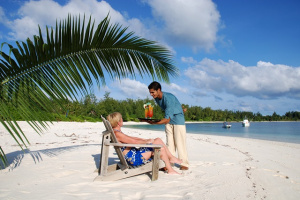Seychelles risks "cutting off its nose to spite its face" with expatriate worker policy, says tourism trade chief
The Interview |Author: Patsy Athanase Edited by: Betymie Bonnelame | January 21, 2022, Friday @ 12:18| 36308 views
One concern that SHTA has voiced repeatedly is the need for businesses to be able to employ quality staff from overseas in situations where there is an insufficient local talent to meet their needs. (Gerard Larose)
(Seychelles News Agency) - A total of 177,504 visitors disembarked in Seychelles in 2021. This was an increase of 54.5 percent from 2020, when there were 114,858 visitors and arrivals were lower than usual due to the COVID-19 pandemic.
SNA spoke to Sybille Cardon, chairperson of the Seychelles Hospitality and Tourism Association (SHTA), to discuss the impact of the ongoing pandemic on the tourism industry as well as other challenges the sector faces including staff recruitment, competitiveness and ensuring high quality of service.
SNA: COVID-19 had an impact on the tourism sector in 2021 but there was a 54.5 percent increase in the number of arrivals compared to 2020. Was this increase felt by the sector?
SC: The increase in visitor numbers in 2021 impacted positively on the tourism sector in Seychelles, however, business remained clearly and painfully far below what we experienced in the last 'normal' year – 2019. It was less than 5 percent in terms of visitor numbers and with revenues at 45 percent of 2019's $590 million.
However, we can draw comfort from the fact that we are in a process of recovery, albeit a fragile one, and that the numbers are moving in the right direction. Our own progress reflects the situation internationally. Our business lifeline - the airlines - globally operated just under 25 million flights in 2021, a 10 percent increase from 2020, but still down 36 percent compared to 2019.
SNA: Russia is now the leading European market. Has the sector been forced to change its marketing strategy to cater for this market?
SC: Russia was our main market last year, significantly due to the three times weekly direct Aeroflot flights from Moscow, followed by the UAE and France. When we break down the nations of origin of our guests, we can see that, in the case of Russia, this is a consequence of marketing strategies, which have been in place since pre-COVID times, and which are now delivering meaningful dividends.
We can also appreciate the huge negative influence of domestic travel restrictions in place in our traditional markets, with lockdowns and testing/quarantine upon return legislation dissuading many potential visitors from visiting our shores. Our own immigration protocols plus the very high cost of PCR tests in Seychelles serve as a further disincentive for example for a family of four considering a trip here.
SNA: Seeing that the pandemic is not abating, what should the sector be doing additionally to get more visitors to our shores?
SC: While it is not abating in terms of the number of infections – quite the opposite in fact - the most recent data suggests that the Omicron variant, which is now globally dominant, is less severe in terms of symptoms, hospitalisations and deaths for fully vaccinated people while being many times more infectious than the previous Delta variant.
The World Health Organisation and other global health bodies are cautiously optimistic that the downgrading of the coronavirus from pandemic to endemic is a realistic and achievable short to medium-term goal. The virus will probably never be eliminated entirely, but as more people get vaccinated and become exposed to it, infections will settle at a consistently low rate and fewer people will become severely ill.
An area where vaccination and booster rates are high, like Seychelles, for example, will probably see endemicity sooner than a region with lower rates.
Many nations are remaining cautious with regard to relaxing travel restrictions too soon. Many tourism professionals globally are, in response, emphatically stating that some administrations are, in fact, being over-cautious, causing further damage to an already blighted industry.
SNA: The Indian Ocean region is a competitive tourism market with other countries like the Maldives and Mauritius. How has it been for Seychelles?
SC: Seychelles has a proven track record of effective marketing, however, in the pre-COVID decade the emphasis for generic destination promotion shifted from what we can refer to as the exclusive/high-end to a more inclusive product, culminating in the 'Affordable Seychelles' campaign, overseen by the (now defunct) Seychelles Tourism Board.
Many in the industry expressed concern about the relationship between the number of visitors and the financial yield. This shift in the type of tourist – one where buses would be taken in preference to taxis, and takeaways consumed instead of a restaurant meal – might be ethically attractive, however, the pressure placed upon our national infrastructure, typically power, water, roads and communications can be seen as unsustainable in the long term.
Infrastructure is utilised by all tourists, regardless of the status of the property they are staying in. Recently, and in the wake of the COVID wake-up call, the model of fewer visitors who spend more money per head is gaining traction.
Competition will always centre on the quality of the holiday experience on offer as well as the price. Some aspects of this pricing are out of our control – flight costs for example – but others, from the room rates themselves to pre-departure [PRC] testing and Travisory [online permit to travel] costs, are things that we can look at in order to create a competitive edge – or at least not suffer a competitive disadvantage - as the global situation stabilises.
In Seychelles, commercial banks, the Central Bank and tourism industry proprietors have tried hard to work together and mitigate the threat of closures forced by the loss of business set against the cost of loans.
In one sense the entire global industry is in dire straits, however, in Seychelles, there is an important additional factor to be considered – namely that tourism provides the lion's share of our national income. If we don't bounce back, then neither will the country.
One concern that SHTA has voiced repeatedly of late is the need for businesses to be able to employ quality staff from overseas in situations where there is an insufficient local talent to meet their needs – which are of course the clients' needs. In the long term, the industry is committed to working increasingly closely with the Seychelles Tourism Academy and the Ministry of Education in order to realise better training for young Seychellois.
This will lead to higher quality graduates who will hopefully be able to occupy key positions in our sector, thus reducing the need for expatriate employees.
However, this will take years, and in the meantime, the government runs the risk of "cutting off its nose to spite its face" by refusing businesses permission to recruit expatriates and instead, trying, for political reasons, to force them to employ locals who are unable – through no fault of their own – to deliver the service standards that our clients expect.
Seychelles remains a comparatively expensive destination and we have to deliver value for money or we will see our national income diminished by lower numbers of bookings, caused in part by the distribution of negative social media comments posted by dissatisfied guests.
 |
| Sybille Cardon, chairperson of the Seychelles Hospitality and Tourism Association (SHTA). (Seychelles Nation) Photo License: CC-BY |
SNA: What is SHTA's working relationship with the new administration?
SC: SHTA and the Department of Tourism meet once every month, including the minister and the senior government tourism team, along with SHTA board members. The relationship is a good one, typified by mutual regard and respect.
The stakes are too high for anything to prevent an open and frank exchange of views at these gatherings, which are supplemented on a 'needs must' basis with less formal contacts. We hope that we will continue to be invited to offer meaningful contributions and that our views will continue to be listened to.
This dialogue follows on from the time of the last administration when SHTA representation on the Safe Tourism Task Force and at State House planning sessions contributed to national policymaking. We have to remember that government administrators and technicians do not run tourism businesses, and this is where the private sector can add value to their thinking. They are also part of an integrated, cross-ministry government machine and possess a bigger picture of what is going on economically and socially.
With regards to the pivotal relationship between government and the Seychelles Tourism Academy – which enjoys close links with the SHTA - it is important that government departments understand that the academy has a mandate which the management team is focused on but which is only deliverable with their explicit support.
STA is happy with its oversight role, which should be exclusively focused upon facilitating decisions made by the technicians and specialists who have been appointed to manage the institution.
When this works well, it epitomises an effective collaboration between the public and the private sectors which benefits all Seychellois and non-Seychellois residents.
SNA: What is SHTA's proposal for the future to attract more visitors?
SC: We hope to be instrumental in the formulation of strategies that will be sorely needed in the future, and perhaps we can close by mentioning some of these priority areas. Firstly, we have to consider most carefully the manner in which client expectations regarding the very nature of a holiday has changed.
For many people the idea of sun, sand and sea in Seychelles remains an attractive one, however, for an increasing number of others, this is simply not enough, particularly when they can obtain these ingredients much more cheaply elsewhere.
The desired and required diversification of our industry was a priority long before COVID came along, with private and public sectors recognising that activity-based, experiential, and cultural tourism need to be developed in order to supplement our traditional offerings. Several newly opened properties are enthusiastically running with this ideology, alongside other more established properties and service providers.
Secondly, the protection and enhancement of our greatest resource – the environment – was also high on the list of priorities pre-COVID, as was the issue of sustainability, with more and more tourists demanding sustainable, 'green' practices in their hotels and guest houses. COVID has, if anything, intensified the importance of these issues, and we collectively need to get to grips with incorporating them within any holistic sector development planning.
Overall, SHTA is convinced that the future of our industry is bright. That does not allow complacency, however, and we will certainly need to fight hard to retain and/or extend our share of whichever markets we decide to prioritize in the future.
COVID-19 has been a disaster for the global tourism industry, but it can be seen to have a few silver linings, one of which is the opportunity – as its virulence recedes – for the hospitality industry to recalibrate, audit and improve what it does.
Back
